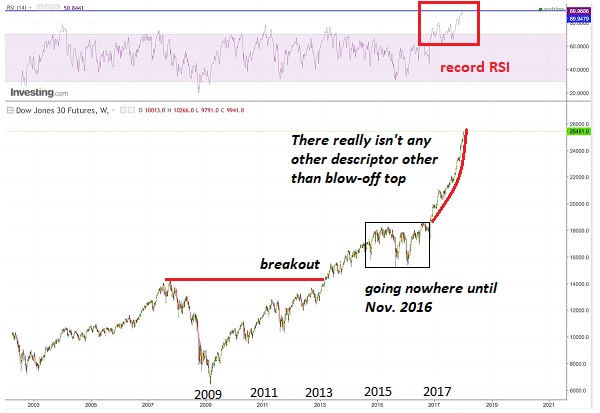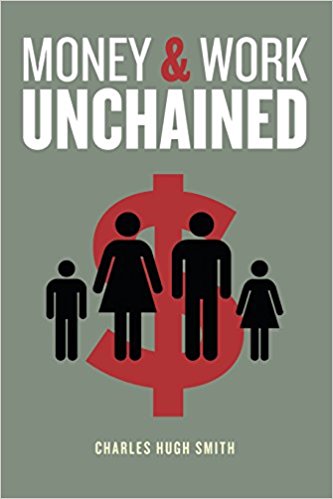Summary:
Central banks have guaranteed a bubble collapse is the only possible output of the system they’ve created. The psychology of blowoff tops in asset bubbles is fascinating: let’s start with the first requirement of a move qualifying as a blowoff top, which is the vast majority of participants deny the move is a blowoff top. Exhibit 1: a chart of the Dow Jones Industrial Average (DJ-30): Is there any other description of this parabolic ascent other than “blowoff top” that isn’t absurdly misleading? Can anyone claim this is just a typical Bull market? There is nothing even remotely typical about the record RSI (relative strength index), record Bull-Bear ratio, and so on, especially after a near-record run of 9 years.
Topics:
Charles Hugh Smith considers the following as important: Featured, newslettersent, The United States
This could be interesting, too:
Central banks have guaranteed a bubble collapse is the only possible output of the system they’ve created. The psychology of blowoff tops in asset bubbles is fascinating: let’s start with the first requirement of a move qualifying as a blowoff top, which is the vast majority of participants deny the move is a blowoff top. Exhibit 1: a chart of the Dow Jones Industrial Average (DJ-30): Is there any other description of this parabolic ascent other than “blowoff top” that isn’t absurdly misleading? Can anyone claim this is just a typical Bull market? There is nothing even remotely typical about the record RSI (relative strength index), record Bull-Bear ratio, and so on, especially after a near-record run of 9 years.
Topics:
Charles Hugh Smith considers the following as important: Featured, newslettersent, The United States
This could be interesting, too:
Eamonn Sheridan writes CHF traders note – Two Swiss National Bank speakers due Thursday, November 21
Charles Hugh Smith writes How Do We Fix the Collapse of Quality?
Marc Chandler writes Sterling and Gilts Pressed Lower by Firmer CPI
Michael Lebowitz writes Trump Tariffs Are Inflationary Claim The Experts
Central banks have guaranteed a bubble collapse is the only possible output of the system they’ve created.
The psychology of blowoff tops in asset bubbles is fascinating: let’s start with the first requirement of a move qualifying as a blowoff top, which is the vast majority of participants deny the move is a blowoff top.
| Exhibit 1: a chart of the Dow Jones Industrial Average (DJ-30):
Is there any other description of this parabolic ascent other than “blowoff top” that isn’t absurdly misleading? Can anyone claim this is just a typical Bull market? There is nothing even remotely typical about the record RSI (relative strength index), record Bull-Bear ratio, and so on, especially after a near-record run of 9 years.
The few who do grudgingly acknowledge this parabolic move might be a blowoff top are positive that it has many more months to run. This is the second requirement of qualifying as a blowoff top: the widespread confidence that the Bull advance has years more to run, and if not years, then many months.
In the 1999 dot-com blowoff top, participants believed the Internet would grow at phenomenal rates for years to come, and thus the parabolic move higher was fully rational.
In the housing bubble’s 2006-07 blowoff top, a variety of justifications of soaring valuations and frantic flipping were accepted as self-evident.
|
Dow Jones 2009 - 2017 |
In the present blowoff top, the received wisdom holds that global growth is just getting started, and corporate profits will soar in 2018. Therefore current sky-high valuations are not just rational, they clearly have plenty of room to rise much higher.
Skeptics are derided as perma-bears who’ve been wrong for 9 long years. This is the third requirement of qualifying as a blowoff top: Bears and other skeptics are mocked and/or dismissed as irrelevant.
Meanwhile, observers who haven’t drunk the punch recognize this as the final leg of a 9-year orgy of central bank stimulus. Pump $14 trillion into global financial assets and all sorts of wonderful things happen, especially if the central banks make it clear in public statements that they will “do whatever it takes,” i.e. assets will not be allowed to decline.
Consider the psychology in play: central bankers have sought to convince private-sector players that central banks will never let markets decline, and so the smart strategy was to buy the dips, and buy every new high–in essence buy, buy, buy and don’t bother hedging long positions, as there was no need to squander money on hedges against declines that would never happen.
Now the central banks are facing runaway asset bubbles that are the direct consequence of their promoting the belief that “central banks will never let markets go down.”
So how do central banks deflate the bubbles gently? How do they change the market psychology without triggering a crash? If central banks cut off the stimulus, and send messages that “now we will let markets decline,” then what’s the rational response?Sell, and sell everything now rather than ride the bubble collapse down.
As I’ve noted before, “We live in a system of human emotions that masquerades as a science (economics).” Central bankers are deluding themselves if they think they can calibrate and fine-tune human emotions. When the Bullish certainty that “central banks have our backs” erodes, the switch to bearish impulses to sell before everyone else sells will be sudden and irreversible.
My new book is Money and Work Unchained. For more, please visit the book's website.
Tags: Featured,newslettersent


